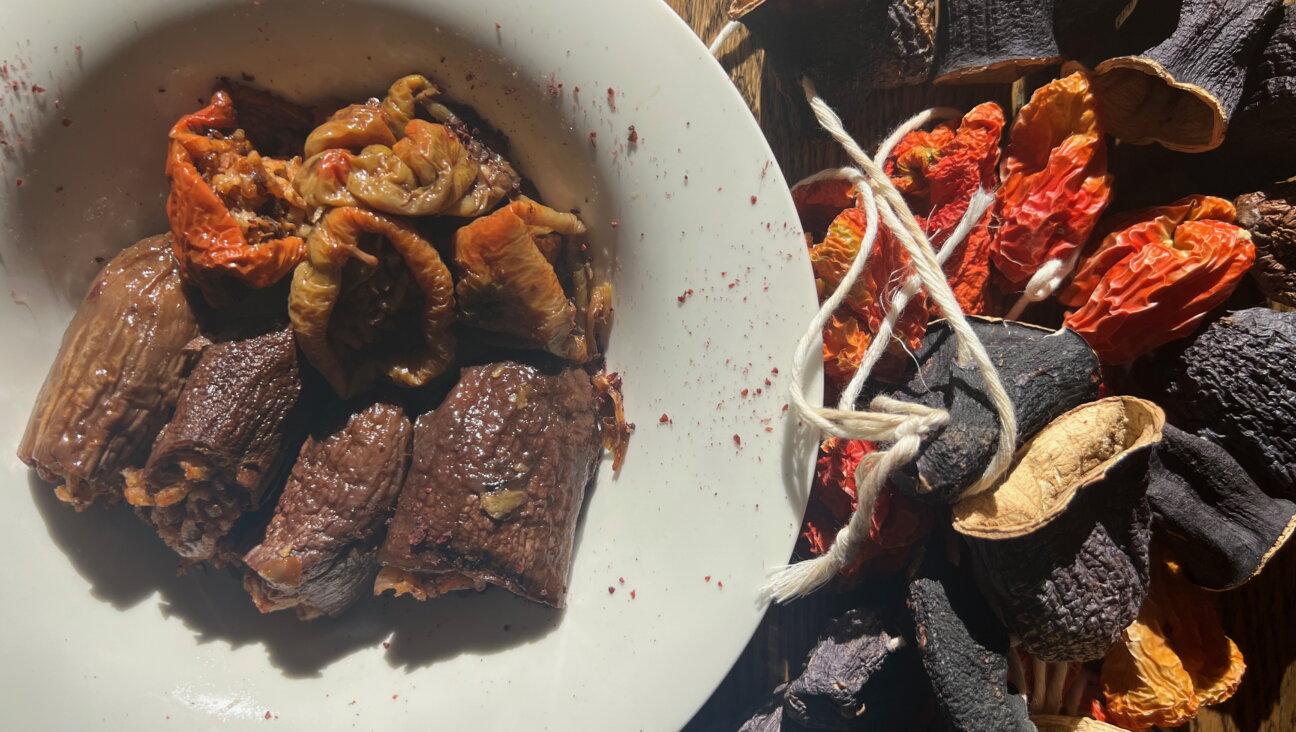Chewdaism: Chew Your Food!

Esquire Editor at Large and experiential journalist A.J. Jacobs embarked on a quest to improve his mind by reading the entire Encyclopedia Britannica. That resulted in the publication of his first book, “The Know-It-All” in 2005. Three years later came “The Year of Living Biblically” chronicling his attempt to raise his spiritual consciousness by growing a wild beard, riding the subway dressed like Moses, and following all the laws of the Bible in their literal sense. Now the 44-year-old Manhattanite has recounted how he tried to achieve bodily perfection in “Drop Dead Healthy” — published earlier this month.
To be sure, a healthy diet and good eating habits would figure into Jacobs’ latest experiment. The question facing the author over the course of his two year investigation, however, was: What exactly is the healthiest diet and what are the healthiest eating habits? Jacobs discovered that some people follow healthy eating habits with a dedication that is akin to religious devotion, like the macrobiotic diet or the author’s Aunt Marti and her raw food regimen. One of the lesser-known habits that Jacobs uncovered has a name that even sounds a lot like a religion very familiar to readers of The Forward. It’s called “Chewdaism.”
Jacobs explains that Chewdaism is a kind of food mindfulness. He discovered that it is “a surprisingly passionate movement.” The central tenet of Chewdaism, is that chewing your food 100 times (Jacobs aimed for a more doable 50) before swallowing it makes you healthier. “They say chewing will cure stomachaches, improve energy, clear the mind, cut down on gas, and strengthen the bones,” Jacobs writes. “Those claims are overblown. But chewing does offer two advantages: You can wring more nutrition out of your food. And more important, chewing makes you thinner, as it forces you to eat more slowly.”
An Internet search for “Chewdaism” yields mainly references to “Drop Dead Healthy.” However, Jacobs told The Jew and the Carrot that he can’t take credit for the term. It’s presumably a portmanteau of “chewing” and “Judaism” (with the latter emphasizing the zeal with which some people adhere to it), but there appears to be no direct connection to Judaism or its food laws.
Jacobs said he first saw the term on a website, though he can’t remember which at this point. Perhaps it was hipchicksmacrobiotic.com, where you can watch a bizarre and borderline nauseating “Converting to Chew-daism” chewing tutorial video and read about a global chew-a-thon. Jacobs wrote in his book that he found pro-chewing websites that quoted Gandhi (“chew your drink and drink your food”), offer pro-chewing poems (“nature will castigate those who don’t masticate”), and sell CD’s that chime every minute that tell you it’s time to swallow.
It seems that historically, we have been “a nation of underchewers,” as Jacobs put it in a piece he wrote for Food and Wine magazine. Chewdaism is simply a new way to refer to an old idea called “Fletcherism” or “Fletcherizing” that was first promulgated more than a century ago by an American named Horace Fletcher. Fletcher, known as “The Great Masticator,” was influential in the world of food and health fads in the late 19th and early 20th centuries. A millionaire businessman and self-taught nutritionist, he spread his extreme chewing doctrine from 1895 until his death in 1919.
Chewdaism plays but one small part in Jacobs’ focus on stomach health and weight control (and the stomach, in turn, is only one of the many organs he focuses on in his book). Over the course of two years, he tried a wide range of diets and portion control techniques. Among them, he: did the Blue Print Cleanse; cut out sugar, but not coffee, alcohol or chocolate (at least not totally); considered both the Paleo (meat-only) diet and extreme calorie restriction, but opted instead for a vegetable-rich, modified Mediterranean diet consisting of a reasonable number of calories; tried eating only raw foods; learned to shop the perimeter of the grocery store; packed high-calorie snacks and treats in single-serving packages; and ate meals on his kids’ small plastic plates with a tiny shrimp fork that he puts down after each mouthful.
Now that Jacobs’ two-year-long quest for bodily perfection is over, he is still following some of things he learned about and tried out during that time. “I am still using small plates, still avoiding white foods like white flower, white sugar, and potatoes. I am still eating lots of protein for breakfast — egg whites and nuts — so that I don’t get hungry an hour later,” he told us. And in terms of extreme chewing, he’s a believer, but not a total convert. “Yes, I still do practice Chewdaism. But I’m more into reform Chewdaism,” he explained. “I found that 50 chews per mouthful was a bit absurd. It takes you a day and a half to eat a sandwich. But 12 to 15 chews is a good goal for me.”
The Forward is free to read, but it isn’t free to produce

I hope you appreciated this article. Before you go, I’d like to ask you to please support the Forward.
Now more than ever, American Jews need independent news they can trust, with reporting driven by truth, not ideology. We serve you, not any ideological agenda.
At a time when other newsrooms are closing or cutting back, the Forward has removed its paywall and invested additional resources to report on the ground from Israel and around the U.S. on the impact of the war, rising antisemitism and polarized discourse.
This is a great time to support independent Jewish journalism you rely on. Make a gift today!
— Rachel Fishman Feddersen, Publisher and CEO
Support our mission to tell the Jewish story fully and fairly.
Most Popular
- 1

Fast Forward Ye debuts ‘Heil Hitler’ music video that includes a sample of a Hitler speech
- 2

Opinion It looks like Israel totally underestimated Trump
- 3

Culture Cardinals are Catholic, not Jewish — so why do they all wear yarmulkes?
- 4

Fast Forward Student suspended for ‘F— the Jews’ video defends himself on antisemitic podcast
In Case You Missed It
-

Culture How one Jewish woman fought the Nazis — and helped found a new Italian republic
-

Opinion It looks like Israel totally underestimated Trump
-

Fast Forward Betar ‘almost exclusively triggered’ former student’s detention, judge says
-

Fast Forward ‘Honey, he’s had enough of you’: Trump’s Middle East moves increasingly appear to sideline Israel
-
Shop the Forward Store
100% of profits support our journalism
Republish This Story
Please read before republishing
We’re happy to make this story available to republish for free, unless it originated with JTA, Haaretz or another publication (as indicated on the article) and as long as you follow our guidelines.
You must comply with the following:
- Credit the Forward
- Retain our pixel
- Preserve our canonical link in Google search
- Add a noindex tag in Google search
See our full guidelines for more information, and this guide for detail about canonical URLs.
To republish, copy the HTML by clicking on the yellow button to the right; it includes our tracking pixel, all paragraph styles and hyperlinks, the author byline and credit to the Forward. It does not include images; to avoid copyright violations, you must add them manually, following our guidelines. Please email us at [email protected], subject line “republish,” with any questions or to let us know what stories you’re picking up.















